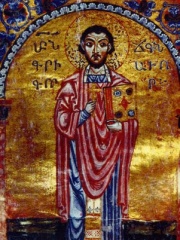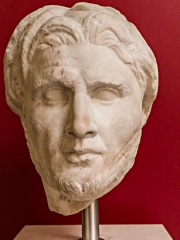






The Most Famous
WRITERS from Turkey
Top 8
The following people are considered by Pantheon to be the most legendary Turkish Writers of all time. This list of famous Turkish Writers is sorted by HPI (Historical Popularity Index), a metric that aggregates information on a biography’s online popularity.

1. Zosimus (460 - 520)
With an HPI of 69.08, Zosimus is the most famous Turkish Writer. His biography has been translated into 38 different languages on wikipedia.
Zosimus (Ancient Greek: Ζώσιμος [ˈzosimos]; fl. 490s–510s) was a Greek historian who lived in Constantinople during the reign of the eastern Roman Emperor Anastasius I (491–518). According to Photius, he was a comes, and held the office of "advocate" of the imperial treasury. Zosimus was also known for condemning Constantine’s rejection of the traditional polytheistic religion. Little more is known about the life of Zosimus except that he was Greek and a pagan. He was not a contemporary of the events of his books.

2. Gregory of Narek (951 - 1003)
With an HPI of 68.74, Gregory of Narek is the 2nd most famous Turkish Writer. His biography has been translated into 33 different languages.
Grigor Narekatsi (Armenian: Գրիգոր Նարեկացի; anglicized as Gregory of Narek; c. 950 – 1003/1011) was an Armenian mystical and lyrical poet, monk, and theologian. He is venerated as a saint in the Armenian Apostolic and Catholic Churches and was declared a Doctor of the Church by Pope Francis in 2015. The son of a bishop, Gregory was educated, ordained, and later stationed at Narekavank on the southern shores of Lake Van (modern Turkey). Scholars consider Gregory the most beloved and significant theological and literary figure of the Armenian religious tradition. He is best known for his Book of Lamentations, a significant piece of mystical literature which serves as a confessional prayer book in many Armenian religious households. His works have inspired many Armenian literary figures and influenced Armenian literature in general throughout the ages.

3. Marcellinus Comes (450 - 534)
With an HPI of 62.06, Marcellinus Comes is the 3rd most famous Turkish Writer. His biography has been translated into 23 different languages.
Marcellinus Comes (Greek: Μαρκελλίνος ό Κόμης, died c. 534) was a Latin chronicler of the Eastern Roman Empire. An Illyrian by birth, he spent most of his life at the court of Constantinople. His only surviving work, the Chronicle, focuses on the Eastern Roman Empire.

4. Paul the Silentiary (520 - 580)
With an HPI of 61.78, Paul the Silentiary is the 4th most famous Turkish Writer. His biography has been translated into 19 different languages.
Paul the Silentiary, also known as Paulus Silentiarius (Greek: Παῦλος ὁ Σιλεντιάριος, died AD 575–580), was a Greek Byzantine poet and courtier to the emperor Justinian at Constantinople.

5. Polemon I of Pontus (-65 - -8)
With an HPI of 60.27, Polemon I of Pontus is the 5th most famous Turkish Writer. His biography has been translated into 24 different languages.
Polemon I Pythodoros (Ancient Greek: Πολέμων Πυθόδωρος; fl. 1st century BC – died 8 BC) was the Roman Client King of Cilicia, Pontus, Colchis and the Bosporan Kingdom. Polemon was the son and heir of Zenon and possibly Tryphaena. Zenon and Polemon adorned Laodicea with many dedicated offerings.

6. Kekaumenos (1020 - 1080)
With an HPI of 58.75, Kekaumenos is the 6th most famous Turkish Writer. His biography has been translated into 20 different languages.
Kekaumenos (Greek: Κεκαυμένος) is the family name of the otherwise unidentified Byzantine author of the Strategikon, a manual on military and household affairs composed c. 1078. He was apparently of Georgian-Armenian origin and the grandson of the doux of Hellas. Despite relevant suppositions, there exists no concrete evidence that he is the famous 11th century general Katakalon Kekaumenos, or his son. His father-in-law was Nikulitzas Delphinas, a lord of Larissa who took part in the revolt of Vlachs (Aromanians) in Thessaly in 1066. The 11th-century scholar Kekaumenos wrote of a Vlach homeland situated "near the Danube and [...] the Sava, where the Serbians lived more recently". He associated the Vlachs with the Dacians and the Bessi. Kekaumenos referred to the Vlachs as an "unfaithful and undisciplined race". He did this in the archaic style of the time, where he pointed to the Balkan area "Dacia Aureliana" and to Macedonia where the Bessi lived.

7. Dares Phrygius (450 - 100)
With an HPI of 57.59, Dares Phrygius is the 7th most famous Turkish Writer. His biography has been translated into 22 different languages.
Dares Phrygius (Ancient Greek: Δάρης), according to Homer, was a Trojan priest of Hephaestus. He was later thought to have been the author of an account of the destruction of Troy. A work in Latin, purporting to be a translation of this, and entitled Daretis Phrygii de excidio Troiae historia, was much read in the Middle Ages, and was then ascribed to Cornelius Nepos, who is made to dedicate it to Sallust; but the language better fits a period much later than the time of Nepos (probably the 5th century AD). It is unknown whether the existing work is an abridgment of a larger Latin work or an adaptation of a Greek original. Together with the similar work of Dictys Cretensis (with which it is generally printed), the De excidio forms the chief source for the numerous medieval accounts of the Trojan legend, the so-called Matter of Troy. Dares claimed 866,000 Greeks and 676,000 Trojans were killed in this war, but archaeology has uncovered nothing that suggests a war this large was ever fought on that site. The work was a significant source for Joseph of Exeter's De bello Troiano. It was also completely reworked in the 8th century in Merovingian Gaul into the work entitled Historia de origine Francorum ('History of the Origins of the Franks'), which purports to describe the descent of the Franks from the Trojans and is attributed to Dares.

8. Diphilus (-350 - -400)
With an HPI of 57.53, Diphilus is the 8th most famous Turkish Writer. His biography has been translated into 15 different languages.
Diphilus (Greek: Δίφιλος), of Sinope, was a poet of the new Attic comedy and a contemporary of Menander (342–291 BC). He is frequently listed together with Menander and Philemon, considered the three greatest poets of New Comedy. He was victorious at least three times at the Lenaia, placing him third before Philemon and Menander. Although most of his plays were written and acted at Athens he died at Smyrna. His body was returned and buried in Athens. According to Athenaeus, he was on intimate terms with the famous courtesan Gnathaena. Athenaeus quotes the comic poet Machon in support of this claim. Machon is also the source for the claim that Diphilus acted in his own plays. An anonymous essay on comedy from antiquity reports that Diphilus wrote 100 plays. Of these 100 plays, 59 titles, and 137 fragments (or quotations) survive. From the extant fragments, Diphilus' plays seem to have featured many of the stock characters now primarily associated with the comedies of the Roman playwright Plautus, who translated and adapted a number of Diphilus' plays. Swaggering soldiers, verbose cooks, courtesans, and parasites, all feature in the fragments. In contrast to his more successful contemporaries, Menander and Philemon, Diphilus seems to have had a preference for the mythological subjects so popular in Middle Comedy. To judge from the imitations of Plautus (Casina from the Κληρούμενοι, Asinaria from the Ὀναγός, Rudens from some other play), he was very skillful in the construction of his plots. Terence also tells us that he introduced into the Adelphi (ii. I) a scene from the Συναποθνήσκοντες, which had been omitted by Plautus in his adaptation (Commorientes) of the same play. According to the Encyclopædia Britannica Eleventh Edition: The style of Diphilus was simple and natural, and his language on the whole good Attic; he paid great attention to versification, and was supposed to have invented a peculiar kind of metre. The ancients were undecided whether to class him among the writers of the New or Middle comedy. In his fondness for mythological subjects (Hercules, Theseus) and his introduction on the stage (by a bold anachronism) of the poets Archilochus and Hipponax as rivals of Sappho, he approximates to the spirit of the latter.
People
Pantheon has 8 people classified as Turkish writers born between 350 BC and 1020. Of these 8, none of them are still alive today. The most famous deceased Turkish writers include Zosimus, Gregory of Narek, and Marcellinus Comes.
Deceased Turkish Writers
Go to all RankingsZosimus
460 - 520
HPI: 69.08
Gregory of Narek
951 - 1003
HPI: 68.74
Marcellinus Comes
450 - 534
HPI: 62.06
Paul the Silentiary
520 - 580
HPI: 61.78
Polemon I of Pontus
65 BC - 8 BC
HPI: 60.27
Kekaumenos
1020 - 1080
HPI: 58.75
Dares Phrygius
450 - 100
HPI: 57.59
Diphilus
350 BC - 400 BC
HPI: 57.53

